Difference between management & leadership
VerifiedAdded on 2023/01/06
|10
|2688
|66
AI Summary
This report analyzes the difference between management and leadership and their impacts on Cranswick plc. It also examines the purpose of leadership and management in meeting the needs of employees and the organization.
Contribute Materials
Your contribution can guide someone’s learning journey. Share your
documents today.
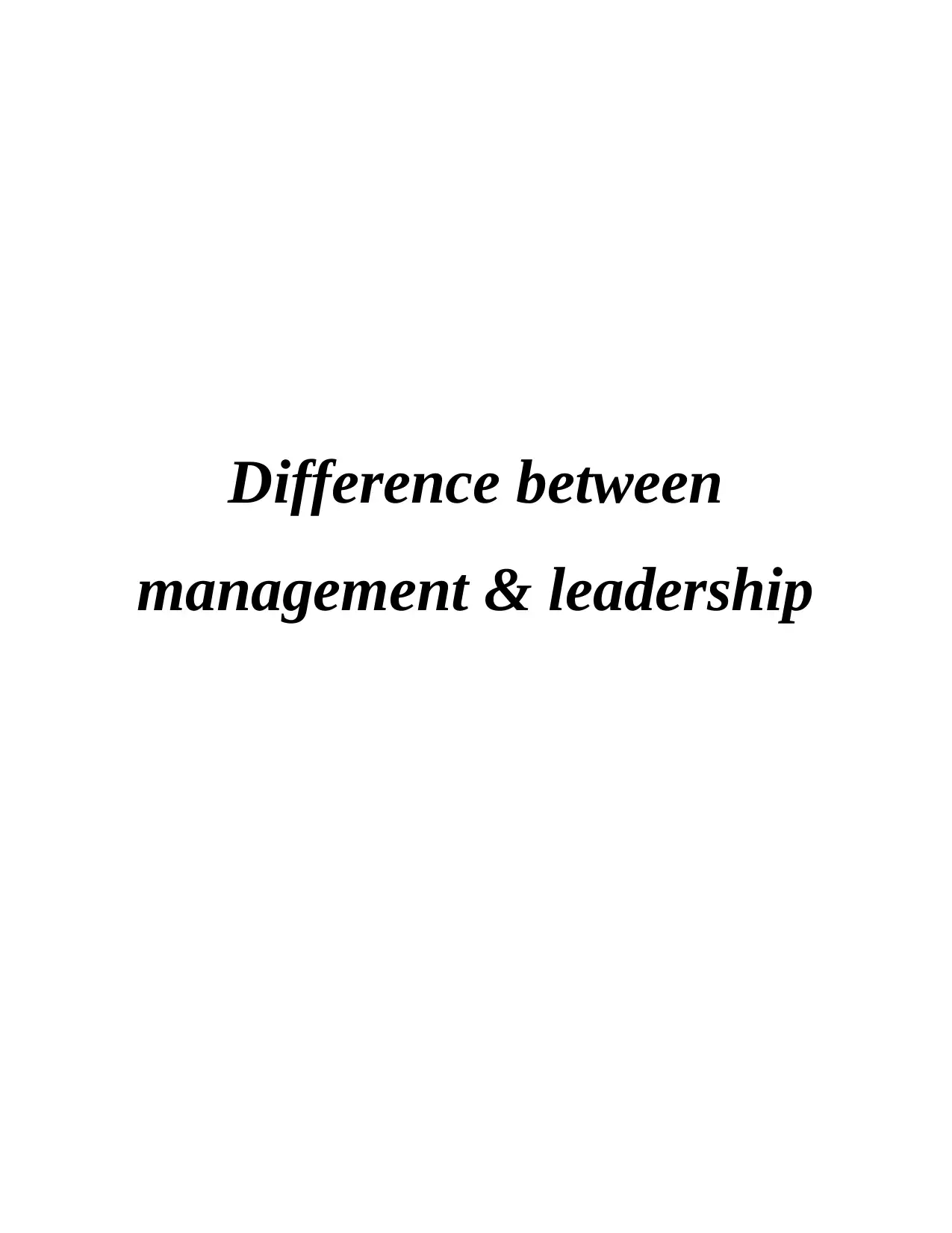
Difference between
management & leadership
management & leadership
Secure Best Marks with AI Grader
Need help grading? Try our AI Grader for instant feedback on your assignments.
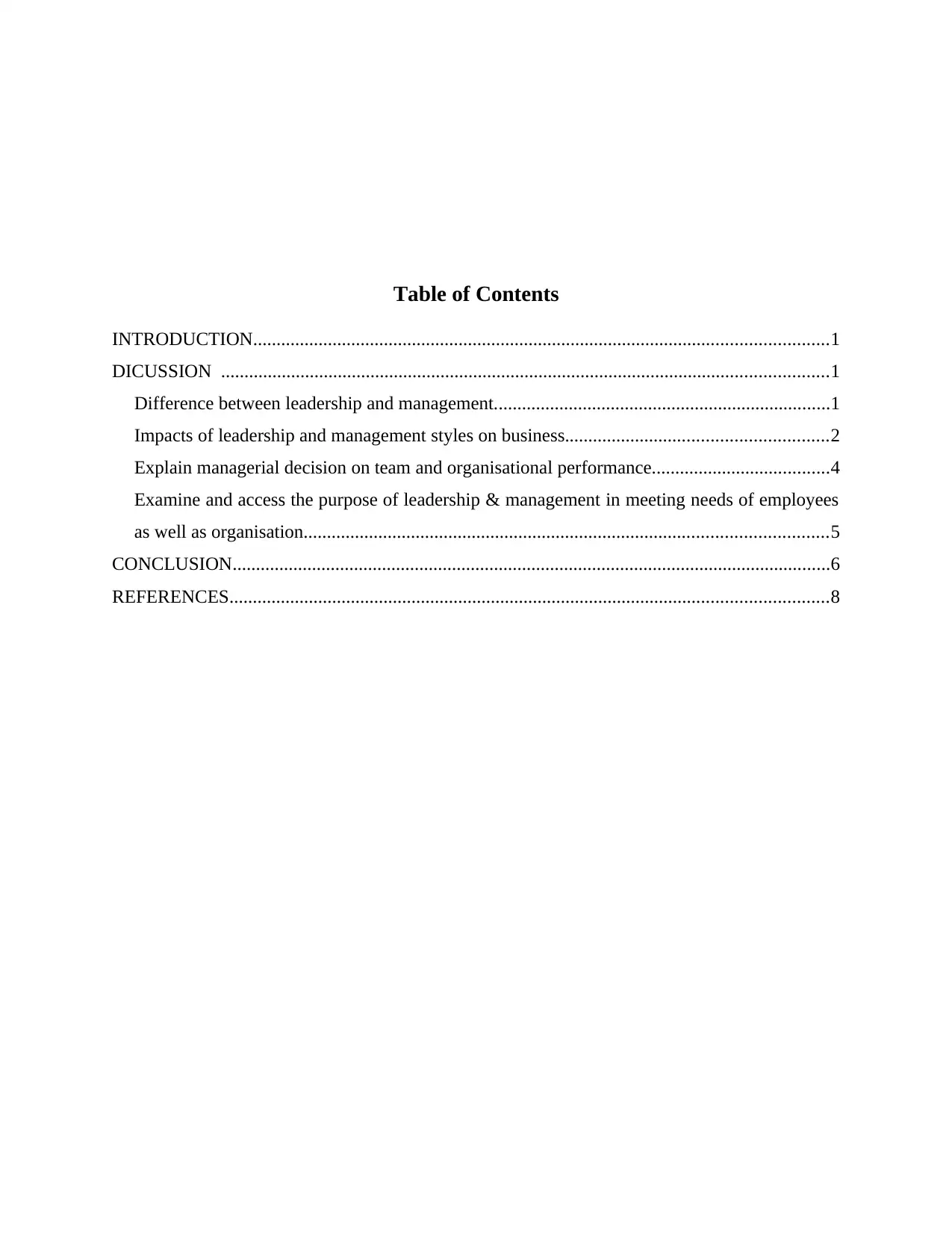
Table of Contents
INTRODUCTION...........................................................................................................................1
DICUSSION ..................................................................................................................................1
Difference between leadership and management........................................................................1
Impacts of leadership and management styles on business........................................................2
Explain managerial decision on team and organisational performance......................................4
Examine and access the purpose of leadership & management in meeting needs of employees
as well as organisation................................................................................................................5
CONCLUSION................................................................................................................................6
REFERENCES................................................................................................................................8
INTRODUCTION...........................................................................................................................1
DICUSSION ..................................................................................................................................1
Difference between leadership and management........................................................................1
Impacts of leadership and management styles on business........................................................2
Explain managerial decision on team and organisational performance......................................4
Examine and access the purpose of leadership & management in meeting needs of employees
as well as organisation................................................................................................................5
CONCLUSION................................................................................................................................6
REFERENCES................................................................................................................................8
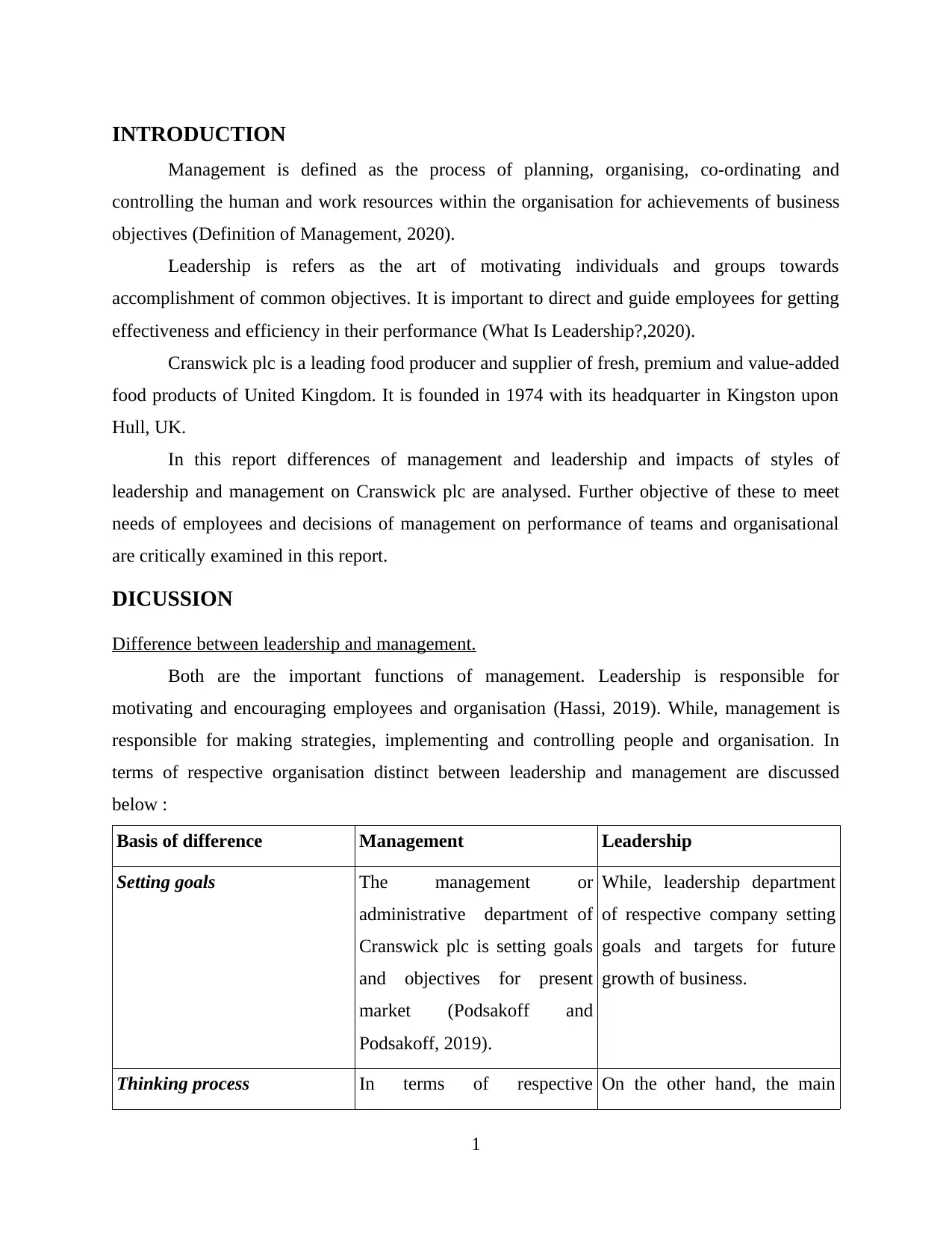
INTRODUCTION
Management is defined as the process of planning, organising, co-ordinating and
controlling the human and work resources within the organisation for achievements of business
objectives (Definition of Management, 2020).
Leadership is refers as the art of motivating individuals and groups towards
accomplishment of common objectives. It is important to direct and guide employees for getting
effectiveness and efficiency in their performance (What Is Leadership?,2020).
Cranswick plc is a leading food producer and supplier of fresh, premium and value-added
food products of United Kingdom. It is founded in 1974 with its headquarter in Kingston upon
Hull, UK.
In this report differences of management and leadership and impacts of styles of
leadership and management on Cranswick plc are analysed. Further objective of these to meet
needs of employees and decisions of management on performance of teams and organisational
are critically examined in this report.
DICUSSION
Difference between leadership and management.
Both are the important functions of management. Leadership is responsible for
motivating and encouraging employees and organisation (Hassi, 2019). While, management is
responsible for making strategies, implementing and controlling people and organisation. In
terms of respective organisation distinct between leadership and management are discussed
below :
Basis of difference Management Leadership
Setting goals The management or
administrative department of
Cranswick plc is setting goals
and objectives for present
market (Podsakoff and
Podsakoff, 2019).
While, leadership department
of respective company setting
goals and targets for future
growth of business.
Thinking process In terms of respective On the other hand, the main
1
Management is defined as the process of planning, organising, co-ordinating and
controlling the human and work resources within the organisation for achievements of business
objectives (Definition of Management, 2020).
Leadership is refers as the art of motivating individuals and groups towards
accomplishment of common objectives. It is important to direct and guide employees for getting
effectiveness and efficiency in their performance (What Is Leadership?,2020).
Cranswick plc is a leading food producer and supplier of fresh, premium and value-added
food products of United Kingdom. It is founded in 1974 with its headquarter in Kingston upon
Hull, UK.
In this report differences of management and leadership and impacts of styles of
leadership and management on Cranswick plc are analysed. Further objective of these to meet
needs of employees and decisions of management on performance of teams and organisational
are critically examined in this report.
DICUSSION
Difference between leadership and management.
Both are the important functions of management. Leadership is responsible for
motivating and encouraging employees and organisation (Hassi, 2019). While, management is
responsible for making strategies, implementing and controlling people and organisation. In
terms of respective organisation distinct between leadership and management are discussed
below :
Basis of difference Management Leadership
Setting goals The management or
administrative department of
Cranswick plc is setting goals
and objectives for present
market (Podsakoff and
Podsakoff, 2019).
While, leadership department
of respective company setting
goals and targets for future
growth of business.
Thinking process In terms of respective On the other hand, the main
1
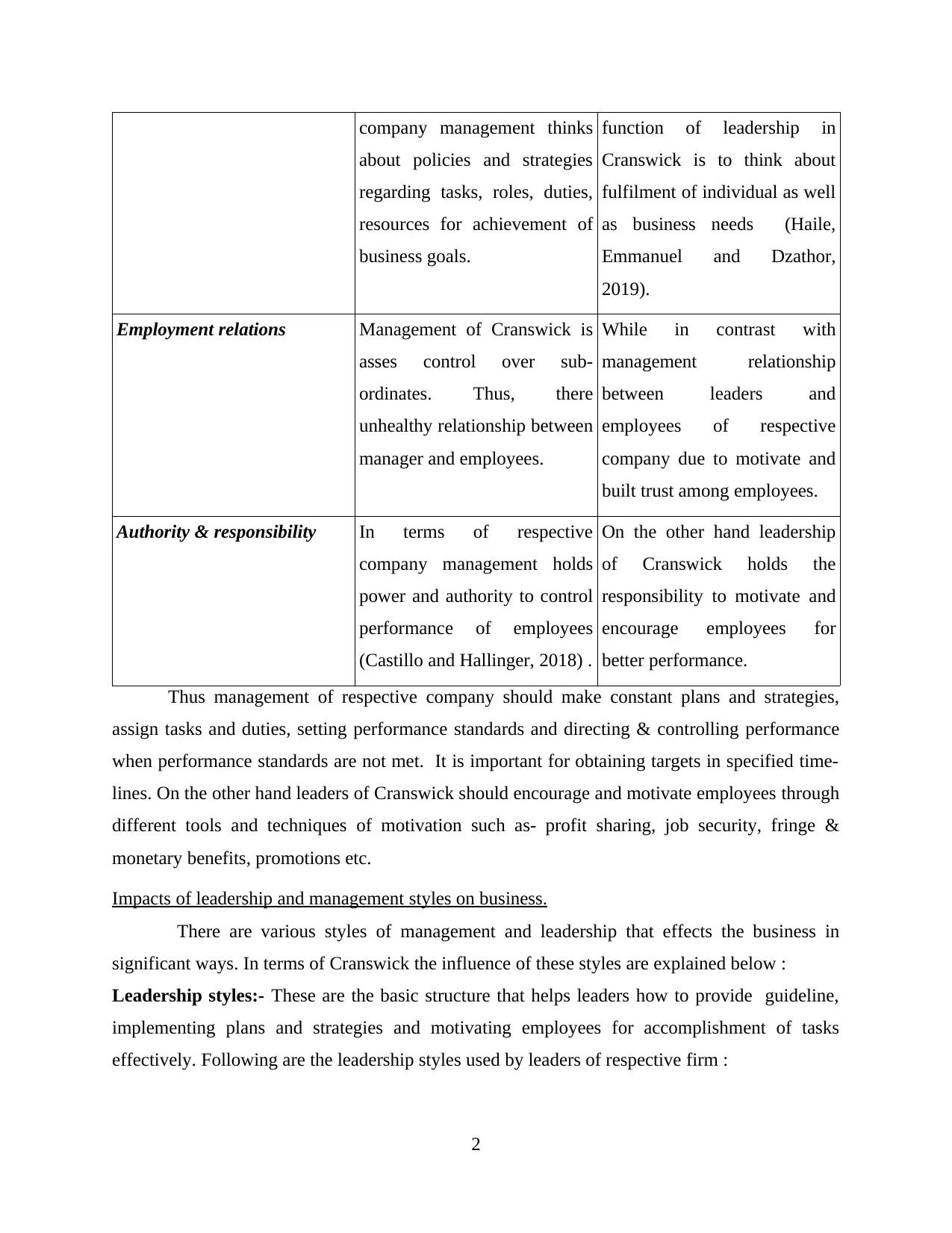
company management thinks
about policies and strategies
regarding tasks, roles, duties,
resources for achievement of
business goals.
function of leadership in
Cranswick is to think about
fulfilment of individual as well
as business needs (Haile,
Emmanuel and Dzathor,
2019).
Employment relations Management of Cranswick is
asses control over sub-
ordinates. Thus, there
unhealthy relationship between
manager and employees.
While in contrast with
management relationship
between leaders and
employees of respective
company due to motivate and
built trust among employees.
Authority & responsibility In terms of respective
company management holds
power and authority to control
performance of employees
(Castillo and Hallinger, 2018) .
On the other hand leadership
of Cranswick holds the
responsibility to motivate and
encourage employees for
better performance.
Thus management of respective company should make constant plans and strategies,
assign tasks and duties, setting performance standards and directing & controlling performance
when performance standards are not met. It is important for obtaining targets in specified time-
lines. On the other hand leaders of Cranswick should encourage and motivate employees through
different tools and techniques of motivation such as- profit sharing, job security, fringe &
monetary benefits, promotions etc.
Impacts of leadership and management styles on business.
There are various styles of management and leadership that effects the business in
significant ways. In terms of Cranswick the influence of these styles are explained below :
Leadership styles:- These are the basic structure that helps leaders how to provide guideline,
implementing plans and strategies and motivating employees for accomplishment of tasks
effectively. Following are the leadership styles used by leaders of respective firm :
2
about policies and strategies
regarding tasks, roles, duties,
resources for achievement of
business goals.
function of leadership in
Cranswick is to think about
fulfilment of individual as well
as business needs (Haile,
Emmanuel and Dzathor,
2019).
Employment relations Management of Cranswick is
asses control over sub-
ordinates. Thus, there
unhealthy relationship between
manager and employees.
While in contrast with
management relationship
between leaders and
employees of respective
company due to motivate and
built trust among employees.
Authority & responsibility In terms of respective
company management holds
power and authority to control
performance of employees
(Castillo and Hallinger, 2018) .
On the other hand leadership
of Cranswick holds the
responsibility to motivate and
encourage employees for
better performance.
Thus management of respective company should make constant plans and strategies,
assign tasks and duties, setting performance standards and directing & controlling performance
when performance standards are not met. It is important for obtaining targets in specified time-
lines. On the other hand leaders of Cranswick should encourage and motivate employees through
different tools and techniques of motivation such as- profit sharing, job security, fringe &
monetary benefits, promotions etc.
Impacts of leadership and management styles on business.
There are various styles of management and leadership that effects the business in
significant ways. In terms of Cranswick the influence of these styles are explained below :
Leadership styles:- These are the basic structure that helps leaders how to provide guideline,
implementing plans and strategies and motivating employees for accomplishment of tasks
effectively. Following are the leadership styles used by leaders of respective firm :
2
Secure Best Marks with AI Grader
Need help grading? Try our AI Grader for instant feedback on your assignments.
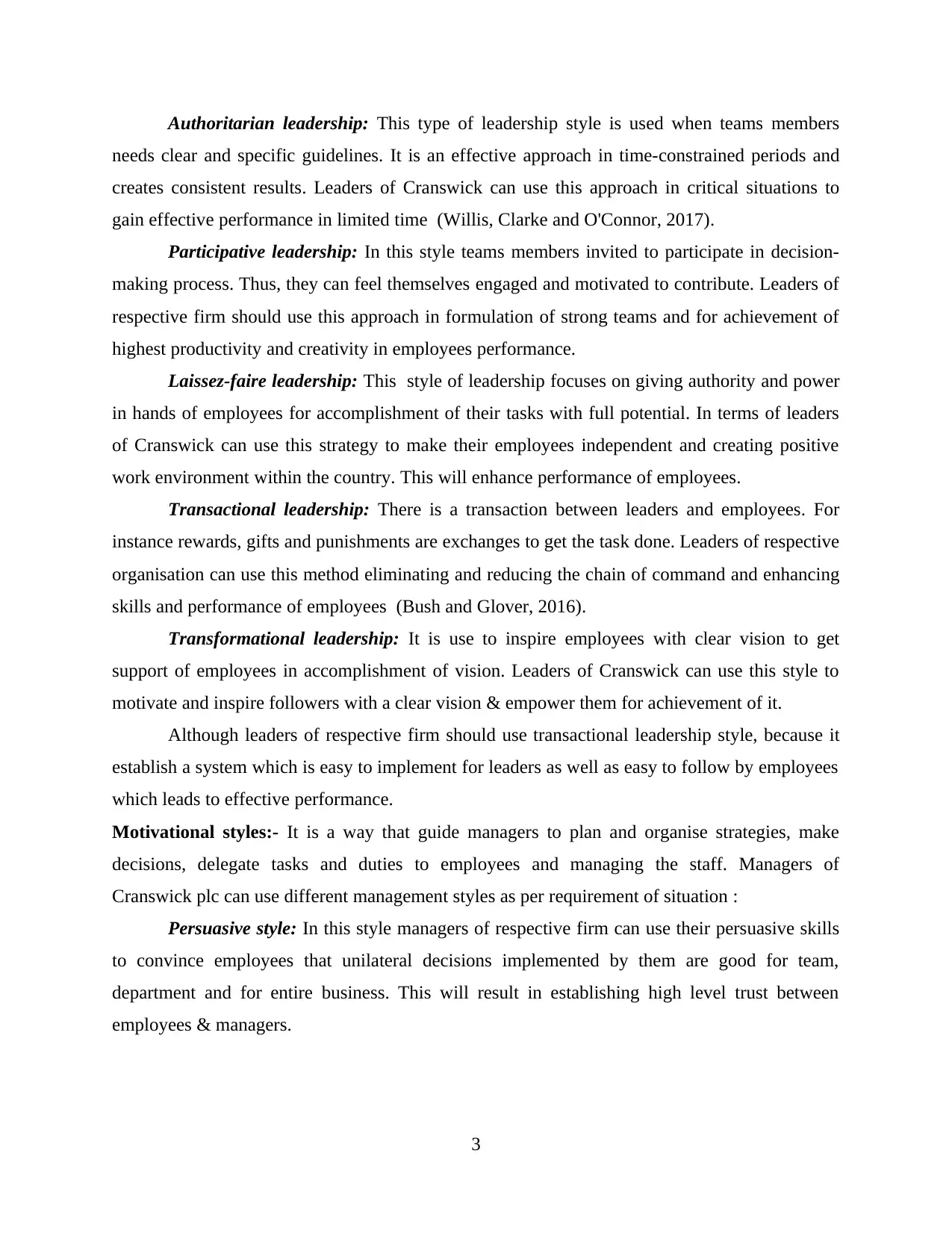
Authoritarian leadership: This type of leadership style is used when teams members
needs clear and specific guidelines. It is an effective approach in time-constrained periods and
creates consistent results. Leaders of Cranswick can use this approach in critical situations to
gain effective performance in limited time (Willis, Clarke and O'Connor, 2017).
Participative leadership: In this style teams members invited to participate in decision-
making process. Thus, they can feel themselves engaged and motivated to contribute. Leaders of
respective firm should use this approach in formulation of strong teams and for achievement of
highest productivity and creativity in employees performance.
Laissez-faire leadership: This style of leadership focuses on giving authority and power
in hands of employees for accomplishment of their tasks with full potential. In terms of leaders
of Cranswick can use this strategy to make their employees independent and creating positive
work environment within the country. This will enhance performance of employees.
Transactional leadership: There is a transaction between leaders and employees. For
instance rewards, gifts and punishments are exchanges to get the task done. Leaders of respective
organisation can use this method eliminating and reducing the chain of command and enhancing
skills and performance of employees (Bush and Glover, 2016).
Transformational leadership: It is use to inspire employees with clear vision to get
support of employees in accomplishment of vision. Leaders of Cranswick can use this style to
motivate and inspire followers with a clear vision & empower them for achievement of it.
Although leaders of respective firm should use transactional leadership style, because it
establish a system which is easy to implement for leaders as well as easy to follow by employees
which leads to effective performance.
Motivational styles:- It is a way that guide managers to plan and organise strategies, make
decisions, delegate tasks and duties to employees and managing the staff. Managers of
Cranswick plc can use different management styles as per requirement of situation :
Persuasive style: In this style managers of respective firm can use their persuasive skills
to convince employees that unilateral decisions implemented by them are good for team,
department and for entire business. This will result in establishing high level trust between
employees & managers.
3
needs clear and specific guidelines. It is an effective approach in time-constrained periods and
creates consistent results. Leaders of Cranswick can use this approach in critical situations to
gain effective performance in limited time (Willis, Clarke and O'Connor, 2017).
Participative leadership: In this style teams members invited to participate in decision-
making process. Thus, they can feel themselves engaged and motivated to contribute. Leaders of
respective firm should use this approach in formulation of strong teams and for achievement of
highest productivity and creativity in employees performance.
Laissez-faire leadership: This style of leadership focuses on giving authority and power
in hands of employees for accomplishment of their tasks with full potential. In terms of leaders
of Cranswick can use this strategy to make their employees independent and creating positive
work environment within the country. This will enhance performance of employees.
Transactional leadership: There is a transaction between leaders and employees. For
instance rewards, gifts and punishments are exchanges to get the task done. Leaders of respective
organisation can use this method eliminating and reducing the chain of command and enhancing
skills and performance of employees (Bush and Glover, 2016).
Transformational leadership: It is use to inspire employees with clear vision to get
support of employees in accomplishment of vision. Leaders of Cranswick can use this style to
motivate and inspire followers with a clear vision & empower them for achievement of it.
Although leaders of respective firm should use transactional leadership style, because it
establish a system which is easy to implement for leaders as well as easy to follow by employees
which leads to effective performance.
Motivational styles:- It is a way that guide managers to plan and organise strategies, make
decisions, delegate tasks and duties to employees and managing the staff. Managers of
Cranswick plc can use different management styles as per requirement of situation :
Persuasive style: In this style managers of respective firm can use their persuasive skills
to convince employees that unilateral decisions implemented by them are good for team,
department and for entire business. This will result in establishing high level trust between
employees & managers.
3
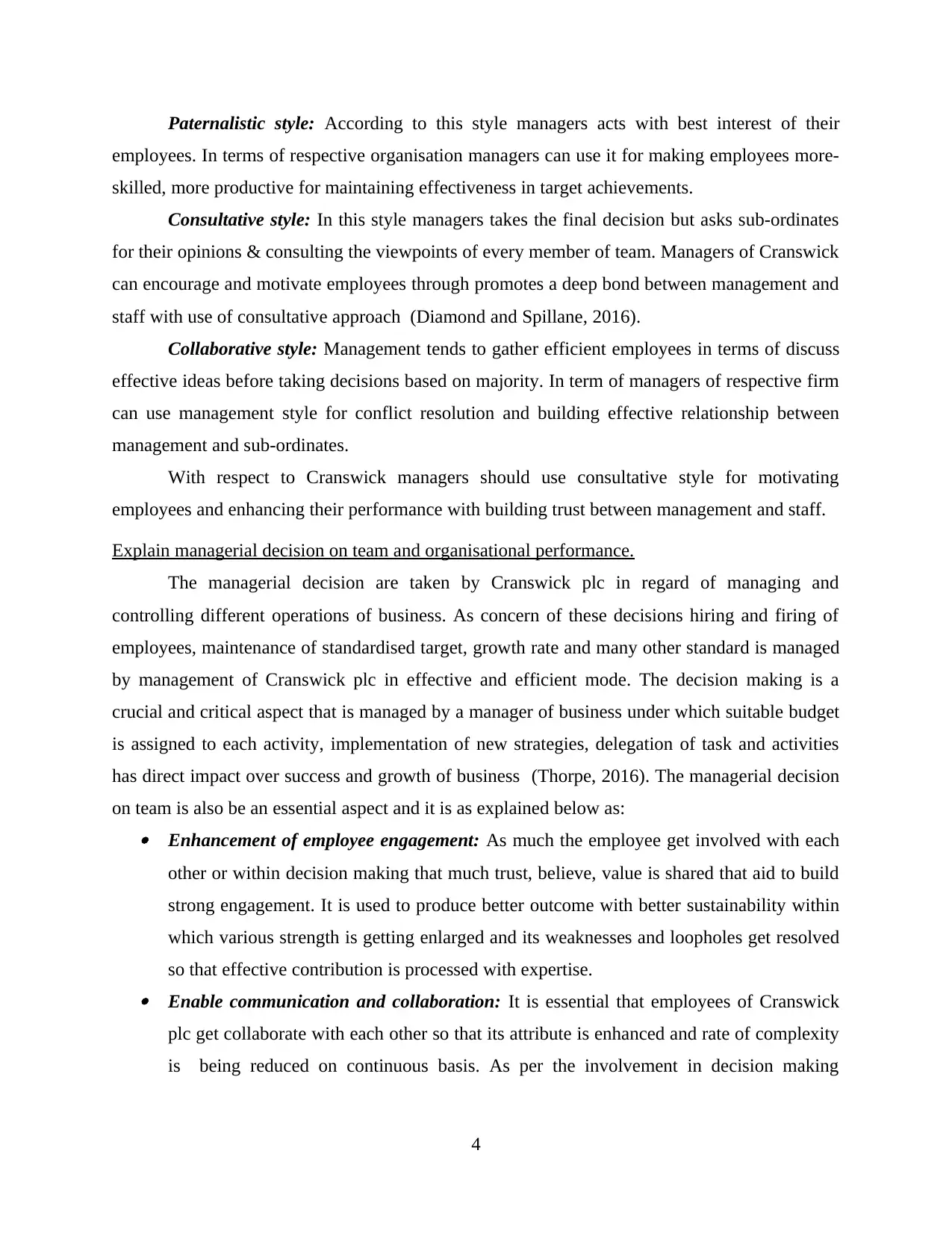
Paternalistic style: According to this style managers acts with best interest of their
employees. In terms of respective organisation managers can use it for making employees more-
skilled, more productive for maintaining effectiveness in target achievements.
Consultative style: In this style managers takes the final decision but asks sub-ordinates
for their opinions & consulting the viewpoints of every member of team. Managers of Cranswick
can encourage and motivate employees through promotes a deep bond between management and
staff with use of consultative approach (Diamond and Spillane, 2016).
Collaborative style: Management tends to gather efficient employees in terms of discuss
effective ideas before taking decisions based on majority. In term of managers of respective firm
can use management style for conflict resolution and building effective relationship between
management and sub-ordinates.
With respect to Cranswick managers should use consultative style for motivating
employees and enhancing their performance with building trust between management and staff.
Explain managerial decision on team and organisational performance.
The managerial decision are taken by Cranswick plc in regard of managing and
controlling different operations of business. As concern of these decisions hiring and firing of
employees, maintenance of standardised target, growth rate and many other standard is managed
by management of Cranswick plc in effective and efficient mode. The decision making is a
crucial and critical aspect that is managed by a manager of business under which suitable budget
is assigned to each activity, implementation of new strategies, delegation of task and activities
has direct impact over success and growth of business (Thorpe, 2016). The managerial decision
on team is also be an essential aspect and it is as explained below as: Enhancement of employee engagement: As much the employee get involved with each
other or within decision making that much trust, believe, value is shared that aid to build
strong engagement. It is used to produce better outcome with better sustainability within
which various strength is getting enlarged and its weaknesses and loopholes get resolved
so that effective contribution is processed with expertise. Enable communication and collaboration: It is essential that employees of Cranswick
plc get collaborate with each other so that its attribute is enhanced and rate of complexity
is being reduced on continuous basis. As per the involvement in decision making
4
employees. In terms of respective organisation managers can use it for making employees more-
skilled, more productive for maintaining effectiveness in target achievements.
Consultative style: In this style managers takes the final decision but asks sub-ordinates
for their opinions & consulting the viewpoints of every member of team. Managers of Cranswick
can encourage and motivate employees through promotes a deep bond between management and
staff with use of consultative approach (Diamond and Spillane, 2016).
Collaborative style: Management tends to gather efficient employees in terms of discuss
effective ideas before taking decisions based on majority. In term of managers of respective firm
can use management style for conflict resolution and building effective relationship between
management and sub-ordinates.
With respect to Cranswick managers should use consultative style for motivating
employees and enhancing their performance with building trust between management and staff.
Explain managerial decision on team and organisational performance.
The managerial decision are taken by Cranswick plc in regard of managing and
controlling different operations of business. As concern of these decisions hiring and firing of
employees, maintenance of standardised target, growth rate and many other standard is managed
by management of Cranswick plc in effective and efficient mode. The decision making is a
crucial and critical aspect that is managed by a manager of business under which suitable budget
is assigned to each activity, implementation of new strategies, delegation of task and activities
has direct impact over success and growth of business (Thorpe, 2016). The managerial decision
on team is also be an essential aspect and it is as explained below as: Enhancement of employee engagement: As much the employee get involved with each
other or within decision making that much trust, believe, value is shared that aid to build
strong engagement. It is used to produce better outcome with better sustainability within
which various strength is getting enlarged and its weaknesses and loopholes get resolved
so that effective contribution is processed with expertise. Enable communication and collaboration: It is essential that employees of Cranswick
plc get collaborate with each other so that its attribute is enhanced and rate of complexity
is being reduced on continuous basis. As per the involvement in decision making
4
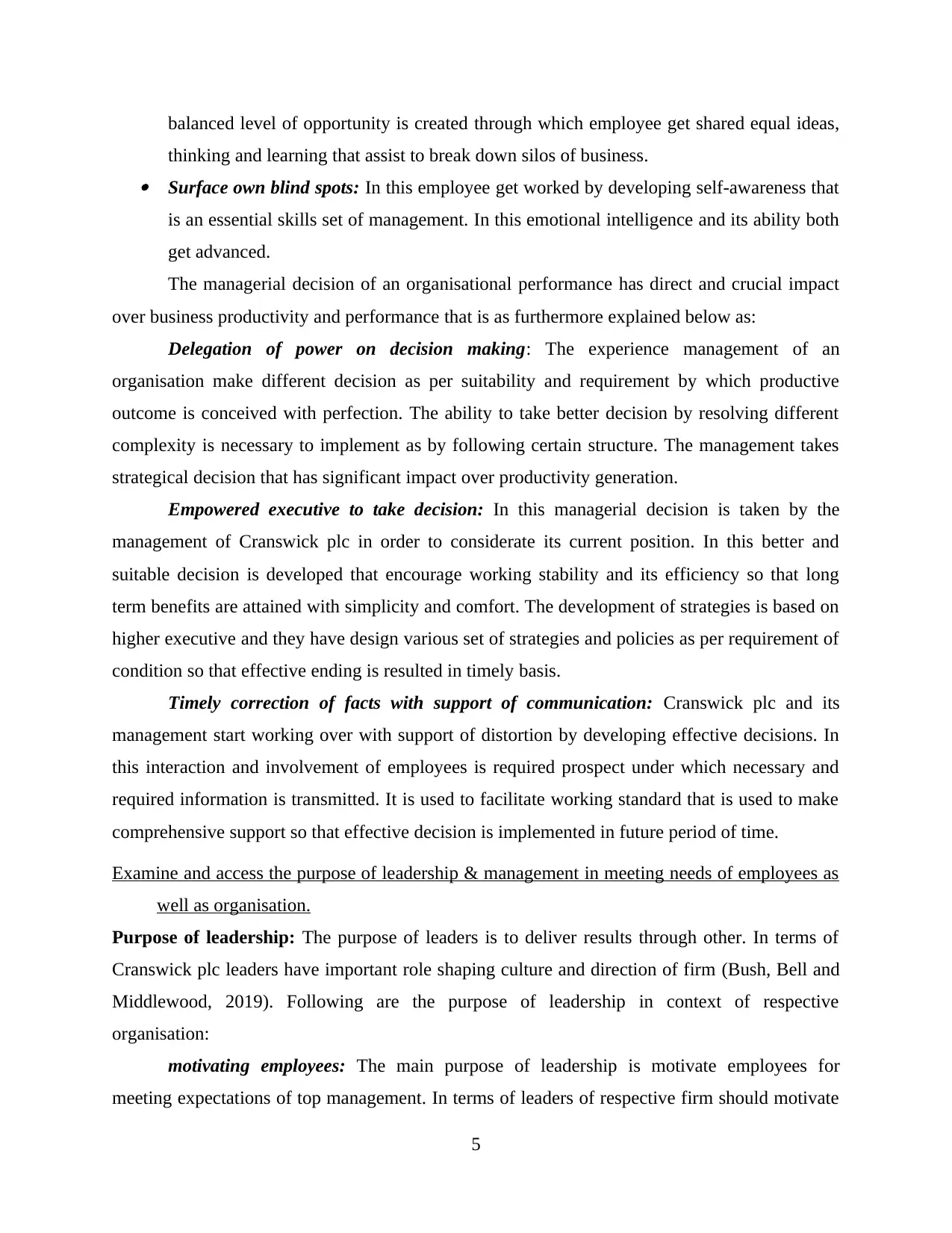
balanced level of opportunity is created through which employee get shared equal ideas,
thinking and learning that assist to break down silos of business. Surface own blind spots: In this employee get worked by developing self-awareness that
is an essential skills set of management. In this emotional intelligence and its ability both
get advanced.
The managerial decision of an organisational performance has direct and crucial impact
over business productivity and performance that is as furthermore explained below as:
Delegation of power on decision making: The experience management of an
organisation make different decision as per suitability and requirement by which productive
outcome is conceived with perfection. The ability to take better decision by resolving different
complexity is necessary to implement as by following certain structure. The management takes
strategical decision that has significant impact over productivity generation.
Empowered executive to take decision: In this managerial decision is taken by the
management of Cranswick plc in order to considerate its current position. In this better and
suitable decision is developed that encourage working stability and its efficiency so that long
term benefits are attained with simplicity and comfort. The development of strategies is based on
higher executive and they have design various set of strategies and policies as per requirement of
condition so that effective ending is resulted in timely basis.
Timely correction of facts with support of communication: Cranswick plc and its
management start working over with support of distortion by developing effective decisions. In
this interaction and involvement of employees is required prospect under which necessary and
required information is transmitted. It is used to facilitate working standard that is used to make
comprehensive support so that effective decision is implemented in future period of time.
Examine and access the purpose of leadership & management in meeting needs of employees as
well as organisation.
Purpose of leadership: The purpose of leaders is to deliver results through other. In terms of
Cranswick plc leaders have important role shaping culture and direction of firm (Bush, Bell and
Middlewood, 2019). Following are the purpose of leadership in context of respective
organisation:
motivating employees: The main purpose of leadership is motivate employees for
meeting expectations of top management. In terms of leaders of respective firm should motivate
5
thinking and learning that assist to break down silos of business. Surface own blind spots: In this employee get worked by developing self-awareness that
is an essential skills set of management. In this emotional intelligence and its ability both
get advanced.
The managerial decision of an organisational performance has direct and crucial impact
over business productivity and performance that is as furthermore explained below as:
Delegation of power on decision making: The experience management of an
organisation make different decision as per suitability and requirement by which productive
outcome is conceived with perfection. The ability to take better decision by resolving different
complexity is necessary to implement as by following certain structure. The management takes
strategical decision that has significant impact over productivity generation.
Empowered executive to take decision: In this managerial decision is taken by the
management of Cranswick plc in order to considerate its current position. In this better and
suitable decision is developed that encourage working stability and its efficiency so that long
term benefits are attained with simplicity and comfort. The development of strategies is based on
higher executive and they have design various set of strategies and policies as per requirement of
condition so that effective ending is resulted in timely basis.
Timely correction of facts with support of communication: Cranswick plc and its
management start working over with support of distortion by developing effective decisions. In
this interaction and involvement of employees is required prospect under which necessary and
required information is transmitted. It is used to facilitate working standard that is used to make
comprehensive support so that effective decision is implemented in future period of time.
Examine and access the purpose of leadership & management in meeting needs of employees as
well as organisation.
Purpose of leadership: The purpose of leaders is to deliver results through other. In terms of
Cranswick plc leaders have important role shaping culture and direction of firm (Bush, Bell and
Middlewood, 2019). Following are the purpose of leadership in context of respective
organisation:
motivating employees: The main purpose of leadership is motivate employees for
meeting expectations of top management. In terms of leaders of respective firm should motivate
5
Paraphrase This Document
Need a fresh take? Get an instant paraphrase of this document with our AI Paraphraser
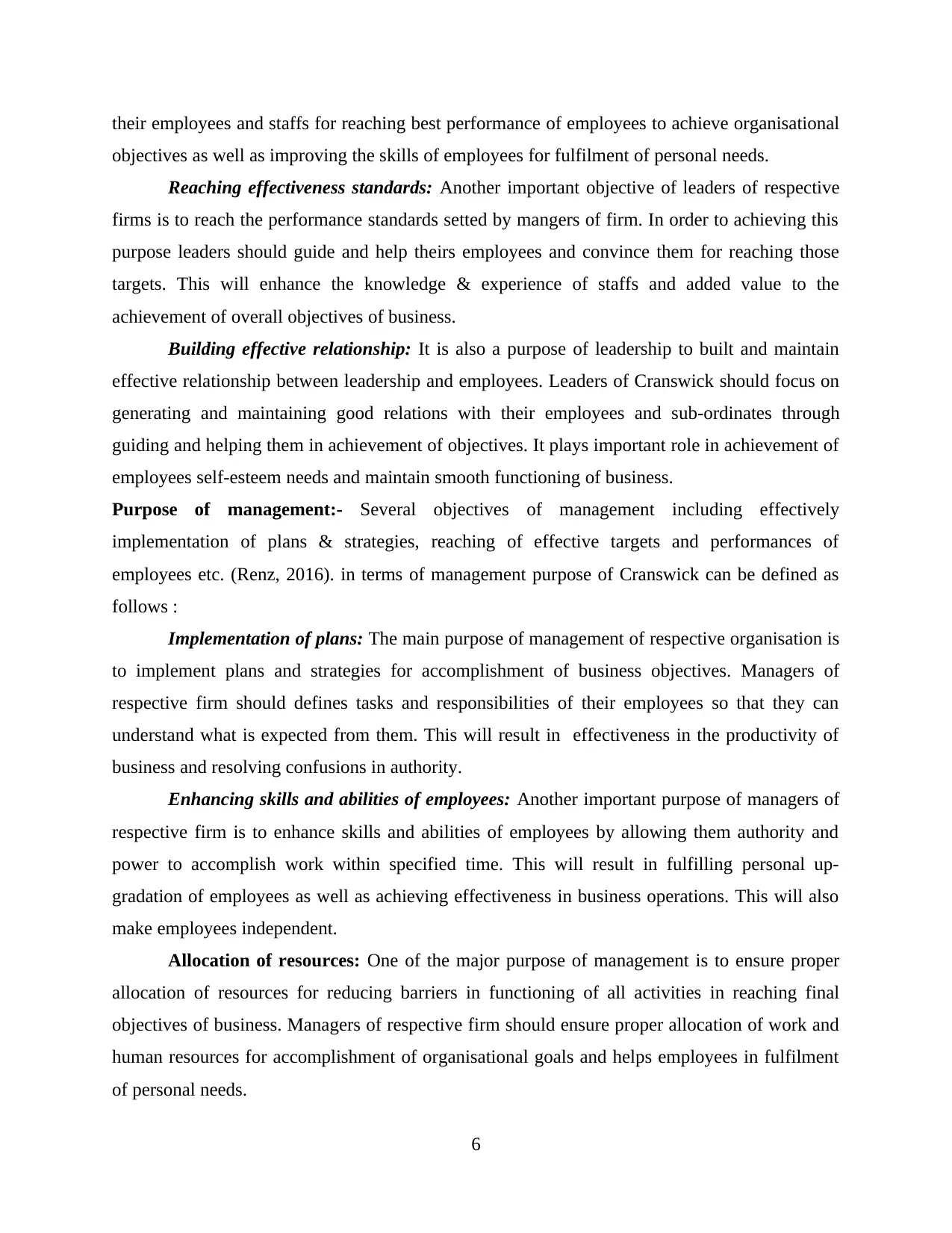
their employees and staffs for reaching best performance of employees to achieve organisational
objectives as well as improving the skills of employees for fulfilment of personal needs.
Reaching effectiveness standards: Another important objective of leaders of respective
firms is to reach the performance standards setted by mangers of firm. In order to achieving this
purpose leaders should guide and help theirs employees and convince them for reaching those
targets. This will enhance the knowledge & experience of staffs and added value to the
achievement of overall objectives of business.
Building effective relationship: It is also a purpose of leadership to built and maintain
effective relationship between leadership and employees. Leaders of Cranswick should focus on
generating and maintaining good relations with their employees and sub-ordinates through
guiding and helping them in achievement of objectives. It plays important role in achievement of
employees self-esteem needs and maintain smooth functioning of business.
Purpose of management:- Several objectives of management including effectively
implementation of plans & strategies, reaching of effective targets and performances of
employees etc. (Renz, 2016). in terms of management purpose of Cranswick can be defined as
follows :
Implementation of plans: The main purpose of management of respective organisation is
to implement plans and strategies for accomplishment of business objectives. Managers of
respective firm should defines tasks and responsibilities of their employees so that they can
understand what is expected from them. This will result in effectiveness in the productivity of
business and resolving confusions in authority.
Enhancing skills and abilities of employees: Another important purpose of managers of
respective firm is to enhance skills and abilities of employees by allowing them authority and
power to accomplish work within specified time. This will result in fulfilling personal up-
gradation of employees as well as achieving effectiveness in business operations. This will also
make employees independent.
Allocation of resources: One of the major purpose of management is to ensure proper
allocation of resources for reducing barriers in functioning of all activities in reaching final
objectives of business. Managers of respective firm should ensure proper allocation of work and
human resources for accomplishment of organisational goals and helps employees in fulfilment
of personal needs.
6
objectives as well as improving the skills of employees for fulfilment of personal needs.
Reaching effectiveness standards: Another important objective of leaders of respective
firms is to reach the performance standards setted by mangers of firm. In order to achieving this
purpose leaders should guide and help theirs employees and convince them for reaching those
targets. This will enhance the knowledge & experience of staffs and added value to the
achievement of overall objectives of business.
Building effective relationship: It is also a purpose of leadership to built and maintain
effective relationship between leadership and employees. Leaders of Cranswick should focus on
generating and maintaining good relations with their employees and sub-ordinates through
guiding and helping them in achievement of objectives. It plays important role in achievement of
employees self-esteem needs and maintain smooth functioning of business.
Purpose of management:- Several objectives of management including effectively
implementation of plans & strategies, reaching of effective targets and performances of
employees etc. (Renz, 2016). in terms of management purpose of Cranswick can be defined as
follows :
Implementation of plans: The main purpose of management of respective organisation is
to implement plans and strategies for accomplishment of business objectives. Managers of
respective firm should defines tasks and responsibilities of their employees so that they can
understand what is expected from them. This will result in effectiveness in the productivity of
business and resolving confusions in authority.
Enhancing skills and abilities of employees: Another important purpose of managers of
respective firm is to enhance skills and abilities of employees by allowing them authority and
power to accomplish work within specified time. This will result in fulfilling personal up-
gradation of employees as well as achieving effectiveness in business operations. This will also
make employees independent.
Allocation of resources: One of the major purpose of management is to ensure proper
allocation of resources for reducing barriers in functioning of all activities in reaching final
objectives of business. Managers of respective firm should ensure proper allocation of work and
human resources for accomplishment of organisational goals and helps employees in fulfilment
of personal needs.
6
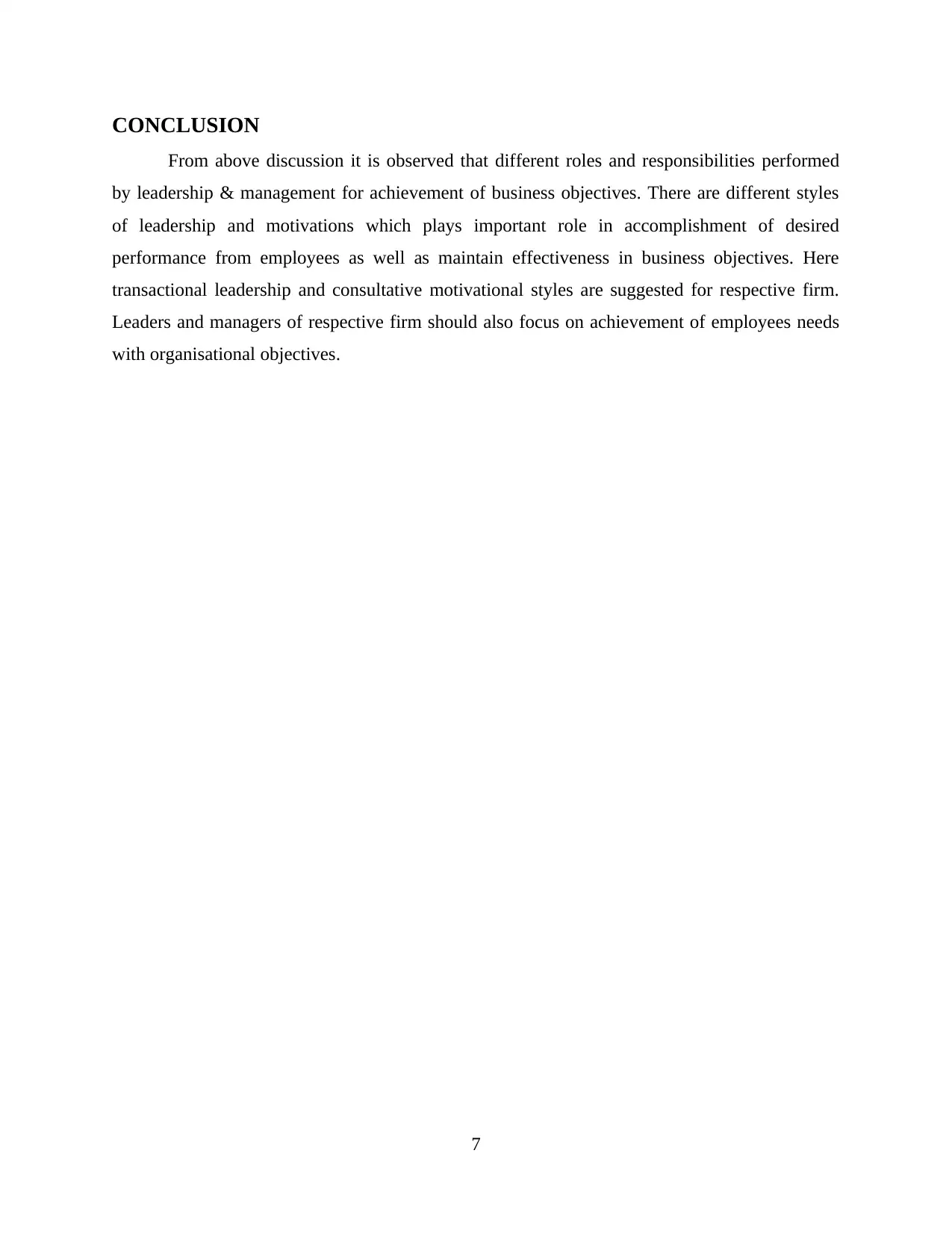
CONCLUSION
From above discussion it is observed that different roles and responsibilities performed
by leadership & management for achievement of business objectives. There are different styles
of leadership and motivations which plays important role in accomplishment of desired
performance from employees as well as maintain effectiveness in business objectives. Here
transactional leadership and consultative motivational styles are suggested for respective firm.
Leaders and managers of respective firm should also focus on achievement of employees needs
with organisational objectives.
7
From above discussion it is observed that different roles and responsibilities performed
by leadership & management for achievement of business objectives. There are different styles
of leadership and motivations which plays important role in accomplishment of desired
performance from employees as well as maintain effectiveness in business objectives. Here
transactional leadership and consultative motivational styles are suggested for respective firm.
Leaders and managers of respective firm should also focus on achievement of employees needs
with organisational objectives.
7
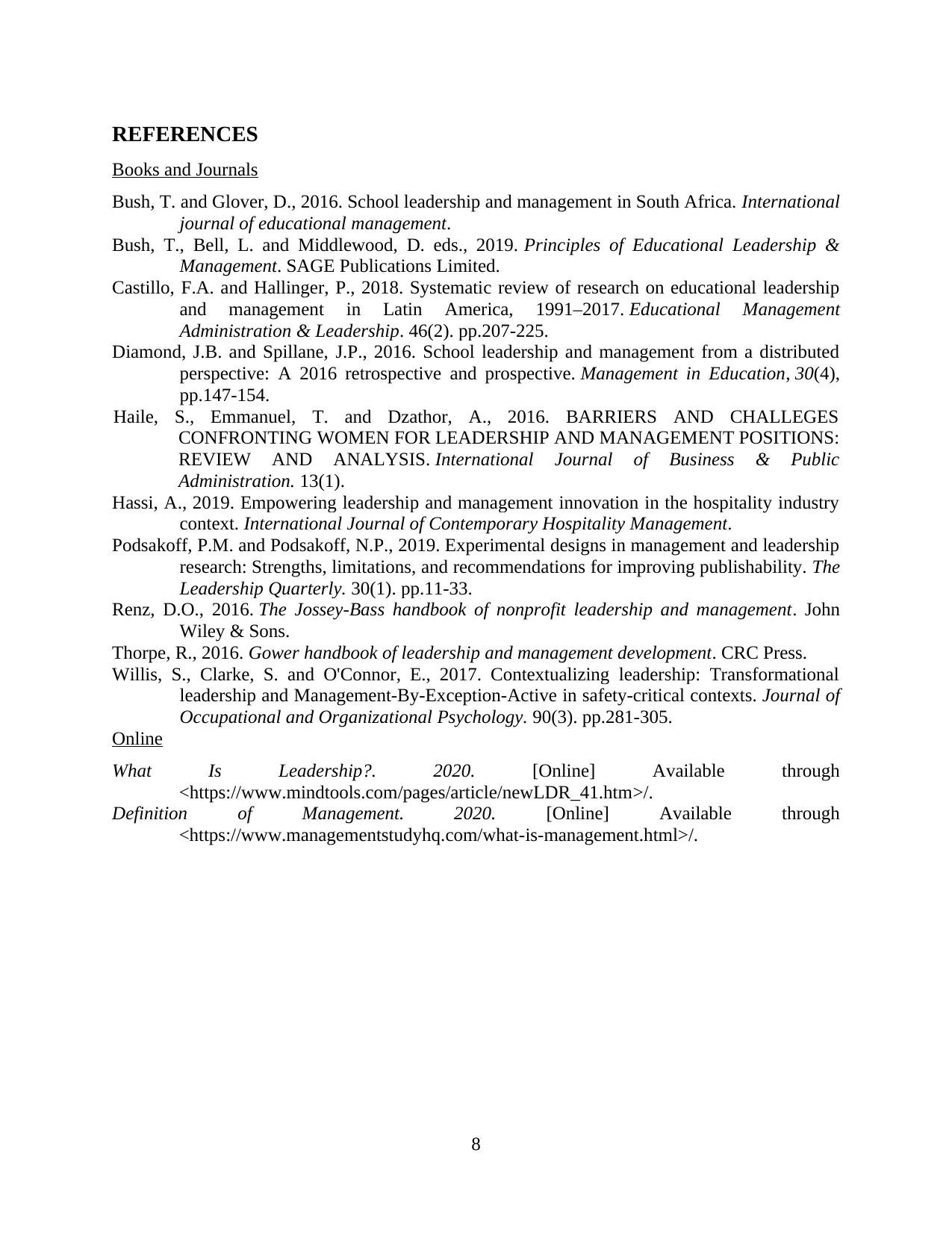
REFERENCES
Books and Journals
Bush, T. and Glover, D., 2016. School leadership and management in South Africa. International
journal of educational management.
Bush, T., Bell, L. and Middlewood, D. eds., 2019. Principles of Educational Leadership &
Management. SAGE Publications Limited.
Castillo, F.A. and Hallinger, P., 2018. Systematic review of research on educational leadership
and management in Latin America, 1991–2017. Educational Management
Administration & Leadership. 46(2). pp.207-225.
Diamond, J.B. and Spillane, J.P., 2016. School leadership and management from a distributed
perspective: A 2016 retrospective and prospective. Management in Education, 30(4),
pp.147-154.
Haile, S., Emmanuel, T. and Dzathor, A., 2016. BARRIERS AND CHALLEGES
CONFRONTING WOMEN FOR LEADERSHIP AND MANAGEMENT POSITIONS:
REVIEW AND ANALYSIS. International Journal of Business & Public
Administration. 13(1).
Hassi, A., 2019. Empowering leadership and management innovation in the hospitality industry
context. International Journal of Contemporary Hospitality Management.
Podsakoff, P.M. and Podsakoff, N.P., 2019. Experimental designs in management and leadership
research: Strengths, limitations, and recommendations for improving publishability. The
Leadership Quarterly. 30(1). pp.11-33.
Renz, D.O., 2016. The Jossey-Bass handbook of nonprofit leadership and management. John
Wiley & Sons.
Thorpe, R., 2016. Gower handbook of leadership and management development. CRC Press.
Willis, S., Clarke, S. and O'Connor, E., 2017. Contextualizing leadership: Transformational
leadership and Management‐By‐Exception‐Active in safety‐critical contexts. Journal of
Occupational and Organizational Psychology. 90(3). pp.281-305.
Online
What Is Leadership?. 2020. [Online] Available through
<https://www.mindtools.com/pages/article/newLDR_41.htm>/.
Definition of Management. 2020. [Online] Available through
<https://www.managementstudyhq.com/what-is-management.html>/.
8
Books and Journals
Bush, T. and Glover, D., 2016. School leadership and management in South Africa. International
journal of educational management.
Bush, T., Bell, L. and Middlewood, D. eds., 2019. Principles of Educational Leadership &
Management. SAGE Publications Limited.
Castillo, F.A. and Hallinger, P., 2018. Systematic review of research on educational leadership
and management in Latin America, 1991–2017. Educational Management
Administration & Leadership. 46(2). pp.207-225.
Diamond, J.B. and Spillane, J.P., 2016. School leadership and management from a distributed
perspective: A 2016 retrospective and prospective. Management in Education, 30(4),
pp.147-154.
Haile, S., Emmanuel, T. and Dzathor, A., 2016. BARRIERS AND CHALLEGES
CONFRONTING WOMEN FOR LEADERSHIP AND MANAGEMENT POSITIONS:
REVIEW AND ANALYSIS. International Journal of Business & Public
Administration. 13(1).
Hassi, A., 2019. Empowering leadership and management innovation in the hospitality industry
context. International Journal of Contemporary Hospitality Management.
Podsakoff, P.M. and Podsakoff, N.P., 2019. Experimental designs in management and leadership
research: Strengths, limitations, and recommendations for improving publishability. The
Leadership Quarterly. 30(1). pp.11-33.
Renz, D.O., 2016. The Jossey-Bass handbook of nonprofit leadership and management. John
Wiley & Sons.
Thorpe, R., 2016. Gower handbook of leadership and management development. CRC Press.
Willis, S., Clarke, S. and O'Connor, E., 2017. Contextualizing leadership: Transformational
leadership and Management‐By‐Exception‐Active in safety‐critical contexts. Journal of
Occupational and Organizational Psychology. 90(3). pp.281-305.
Online
What Is Leadership?. 2020. [Online] Available through
<https://www.mindtools.com/pages/article/newLDR_41.htm>/.
Definition of Management. 2020. [Online] Available through
<https://www.managementstudyhq.com/what-is-management.html>/.
8
1 out of 10
Related Documents
Your All-in-One AI-Powered Toolkit for Academic Success.
+13062052269
info@desklib.com
Available 24*7 on WhatsApp / Email
![[object Object]](/_next/static/media/star-bottom.7253800d.svg)
Unlock your academic potential
© 2024 | Zucol Services PVT LTD | All rights reserved.





